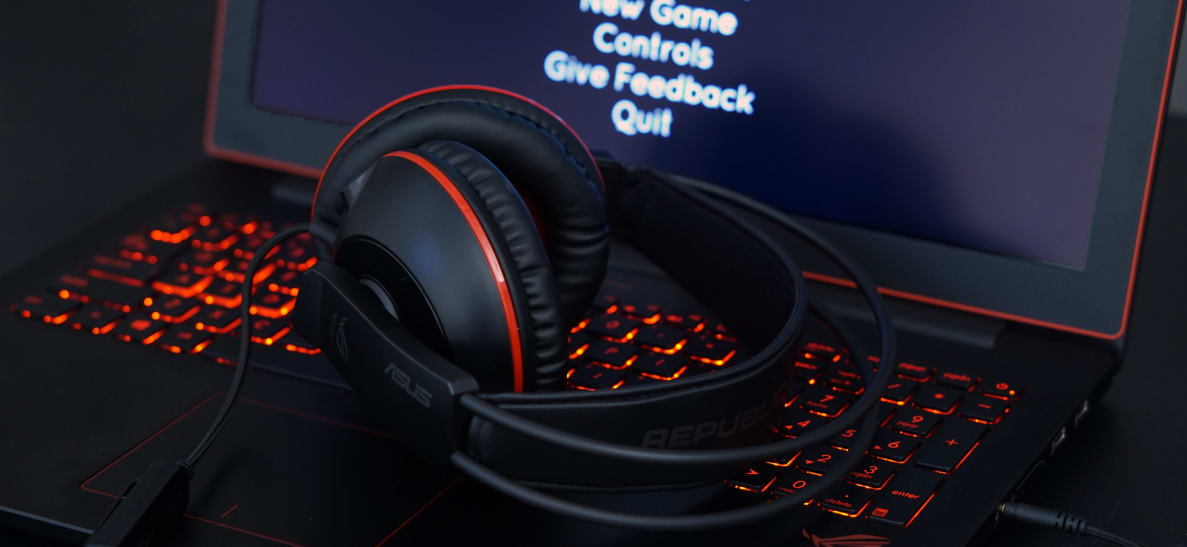Pros
Cons
Thankfully, there are plenty of options to choose from, and Asus offers some very affordable ones. Take the Cerberus Gaming Headset (MSRP: $75.50), for example. As far as gaming headsets go, the Cerberus is definitely on the affordable end and fans of first-person shooter games will enjoy their emphasis on bass sounds and large, encompassing earcups.
There’s no doubt that they’ll get the job done, but they aren’t a top-of-the-line option and, unfortunately, it shows. The materials aren’t exactly high-end and the higher pitched sounds get seriously downplayed—enough that details will be lost in favor of booming explosions. If you prefer to game casually and just need something so you don’t bother your housemates, the Cerberus is acceptable—just don't expect it to blow you away.
The Look
Nothing new or exciting
The Cerberus is about as standard as it comes for gaming headsets in the looks department. Like almost every other gaming headset, it features large, in-your-face earcups, an all-plastic housing, and sharp angles. You don’t get to be picky when it comes to customizing the Cerberus either, there’s only an option for the traditional Asus color scheme of black and red.
Asus chose to ditch the standard adjustments on over-ear headphones and opt instead for a self-adjusting band that’s a one-size-fits-all option. Thanks to this, it’s only comfortable in the most superficial ways. While the stretchable band ensures that the Cerberus will almost certainly fit, it never felt totally secure. This led to me losing some of the immersive experience I expect when using over-ear headphones.
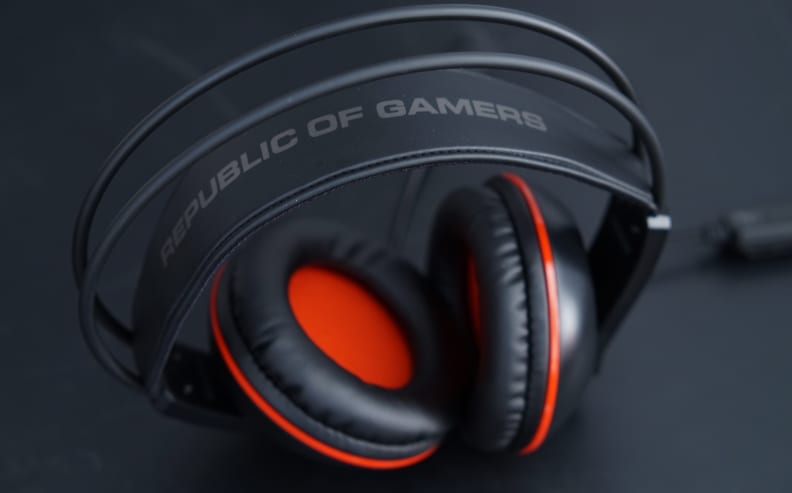
The one size fits all headband rests comfortably, but can feel a little loose.
A comfortable fit takes more than just headband adjustments though; you need comfortable earcups too. The earcups on the Cerberus are large and wrapped in a leather-like material with just enough padding to rest comfortably against my head while completely encompassing my ears. There was even enough space between my ears and the interior that my ears never started to hurt or feel hot.
The four foot braided cable is long enough to work with laptops—or even the PS4 controller—but might not reach your desktop depending on your setup. It also includes an in-line remote and microphone so you can easily go from gaming to using your smartphone; or at least that’s the intention. The remote only includes a dial for volume and a mic on/off switch, but not a button for controlling your music or answering phone calls. So while you can technically use the Cerberus with a smartphone, your capabilities are limited to the point that it isn't very practical.
There also isn’t a way to collapse the Cerberus to a smaller, more portable size. If you’re a fan of gaming on the go, you’ll be forced to lug the Cerberus as a bulky bundle sans carrying case. Instead of the standard accessories included with headphones, gaming headsets instead shift focus to the the needs of gamers.
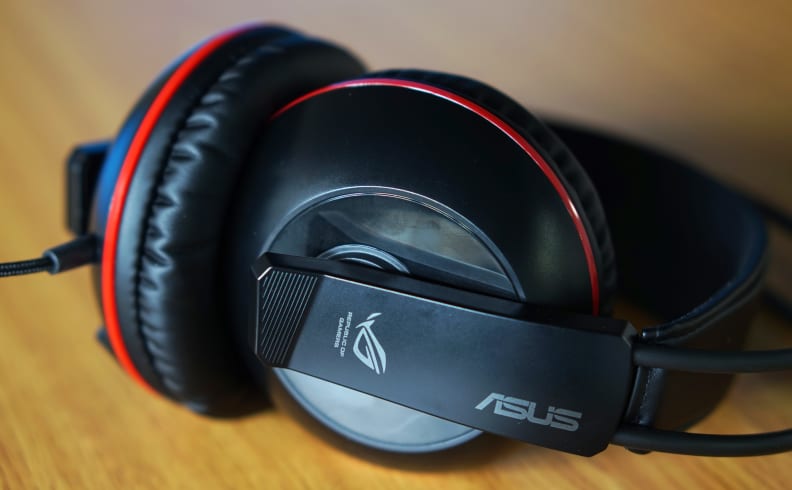
The earcups are large enough to completely encase your ears.
For the Cerberus headset this boils down to two adapters and a detachable mic. The first adapter that the Cerberus comes with is an audio/mic splitter. It does exactly what its name suggests, splitting the single headset jack into two: one for the microphone and one for the sound.
The other adapter is used to tackle a much more serious problem found with cables that have in-line remotes. We’ve encountered issues like the volume controls not working or only one side of the headphones playing sound, and it all comes down to the type of phone you’re using—Apple or Android. Anticipating the potential for this problem, Asus bundled an adapter that’ll take care of any these kind of issues that you might have, regardless of operating system.
Rounding out the accessories is a detachable boom mic. While it's possible to use the in-line mic while playing games, you're going to want to use the detachable boom mic. It's adjustable, and can be shaped to be as close to—or far away from—your mouth as you’d like. Unfortunately, it encounters a lot of the same problems as other budget microphones—a slight distortion that hampers the quality of your voice. It's still good enough that your teammates shouldn't have an issue, but it's certainly not the best option out there.
The Sound
Good enough to get the job done.
It’s difficult to gauge the effectiveness of gaming headsets because, generally, they’re built to emphasize certain sounds that traditional headphone manufacturers don’t even think about. You won’t care as much about the music if you’re playing a first-person shooter after all. Instead you’ll want to be able to hear the enemy’s footsteps as they attempt to flank you, or the direction the latest burst of gunfire is coming from. Likewise, if you’re deep into a game like The Witcher 3: Wild Hunt you’re going to want to hear every turn in the dynamic orchestral score to set the mood for the next adventure.
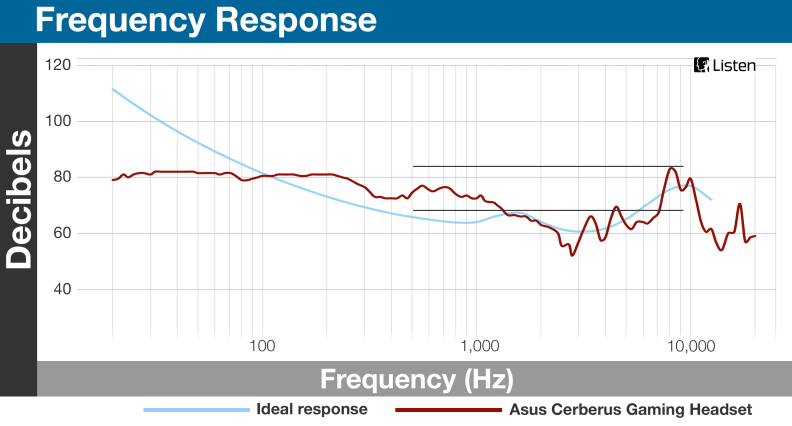
Bass frequencies stick close to 80dB, but the midrange and treble frequencies take a significant drop.
The Cerberus over-ears are definitely geared more towards the FPS crowd. Bass is given a much greater emphasis than the rest of the audible spectrum so you can expect to hear those explosions and gunfire clearly above the music in Battlefield 4 or Call of Duty: Advanced Warfare.
Unfortunately, these are not the headphones you’ll want if you plan on playing anything with a complex orchestral score. The treble frequencies aren’t given nearly enough attention and will be lost in favor of the deeper sounds. That goes for all of your typical music as well, as bass overwhelms everything else in the mix, drowning out vocals and high pitched sounds.
And despite their big, enveloping earcups, these headphones don't do a good job of isolating you from your surroundings. Taken on their own—without any music playing—the Cerberus is only able to block sounds that you’re unlikely to encounter in a typical gaming environment. The deep bass sounds won’t be blocked at all and the midrange sounds—like people talking—will only get a small decrease, if at all. Don’t be completely discouraged though, they’ll be able to block a little more ambient sound once you start pumping tunes through them.
Likewise, the Cerberus don't do so well when it comes to keeping sound in. Even at a normal volume a healthy dose of it will leak out. If you have roommates and play games in a communal area it's almost a guarantee that you'll hear them and they'll hear your game.
The Verdict
The Cerberus won’t do it for pro-gamers.
A gaming headset isn’t absolutely necessary to enjoy a video game, but it lends a sense of immersion even the best speakers will struggle to replace. Unfortunately, the Cerberus gaming headset from Asus is firmly stuck in the ranks of amateurs, not enthusiasts. In a cutthroat world where gamers look for every advantage they can get, the Cerberus just doesn’t match up.
Instead, we’d recommend the Logitech G230 Gaming Headset (MSRP: $59.99). It’s as simple and barebones as the Cerberus headset, but with the advantage of a more impressive sound output. As far as cost to performance goes, the Logitech G230 is a pretty great deal. Sure, there are gaming headsets that sound better, but you’re going to shell out some serious extra dough for them.

The self-adjusting headband should ensure that no matter what you'll have a comfortable fit.
If the G230s don’t quite do it for you, but you’re not willing to commit a truckload of money, you might be interested in the Razer Carcharias (MSRP: $79.99). They’re a little pricier than the Cerberus and the G230s, but are a no-frills headset that’s great for gamers looking to dabble in improving their experience.
While there are definitely other—arguably better—headsets, the Cerberus is a prime example of what to expect in this price range. Most pros won’t think twice about dropping a couple hundred dollars on a single piece of equipment for their gaming rig, and a headset is no different. If you don’t expect the world and just want music pumped straight into your ears, the Cerberus perform well enough to finish the job.
The Insides That Count
While the Asus Cerberus Gaming Headset isn’t necessarily the best option on the market, it performs well enough that casual gamers probably won’t be too disappointed. Fans of bass don’t have anything to fear as those are the only frequencies that aren’t downplayed by the Cerberus. While other frequencies don't get as much love, there won’t be any fuzzy, crackling sounds interrupting your music and the headphones manage to block a decent amount of ambient sound. I’ll go through each of these in more detail below and lay out the science behind the results we found.
Frequency Response
When we test the frequency response of a pair of headphones we start with a parent signal of 78dB and measure the headphone output across the audible spectrum. There are typically two types of ideal responses, one that follows an equal-loudness contour (represented by the blue line in the chart) and the other which is a flat response (represented by the two black bars) for work in a studio. The results from the Cerberus are closer to a flat response, but there are some notable issues in the treble frequencies.

Bass frequencies stick close to 80dB, but the midrange and treble frequencies take a significant drop.
Sub-bass and bass sounds (0–300Hz) actually get a slight boost so they hover around 81dB which is great news for explosions and gunfire of first-person shooters. Right at 300dB—where the frequencies shift into the midrange—the decibel level drops to about 71dB. That 10dB difference might not seem like much, but it means that those sounds are half as loud as what we hear from the bass.
There isn’t another serious drop until the high mids (2–6kHz) where it gets to about 53dB just below 3kHz. The treble sounds that are in this range will sound like they’re 1/8th as loud as the bass sounds. That’s enough of a difference that some sounds are going to be lost in the mix and it’ll be difficult to pick out the details.
Distortion
Distortion—the fuzzy, mechanical noise that sounds kind of like static—is one area where the Cerberus does well. Even though it's mostly noticeable in headphones that have a subpar build quality or those that you’ve had and used for years on end, the Cerberus has a low enough measure of distortion to be noticeable. For reference, we don’t consider distortion to be audible until it reaches about 3% or higher on our chart.
The Cerberus doesn’t quite reach 3% and instead barely hits 2% at its highest mark for the sub-bass frequencies. Normally, audiophiles or those with sensitive hearing could still hear distortion at this percentage, but it’s difficult even for them to pick up discrepancies in the sub-bass and bass ranges. While it's still possible to hear the unwanted sounds of distortion in the Cerberus, it's unlikely anyone without particularly sensitive hearing will.
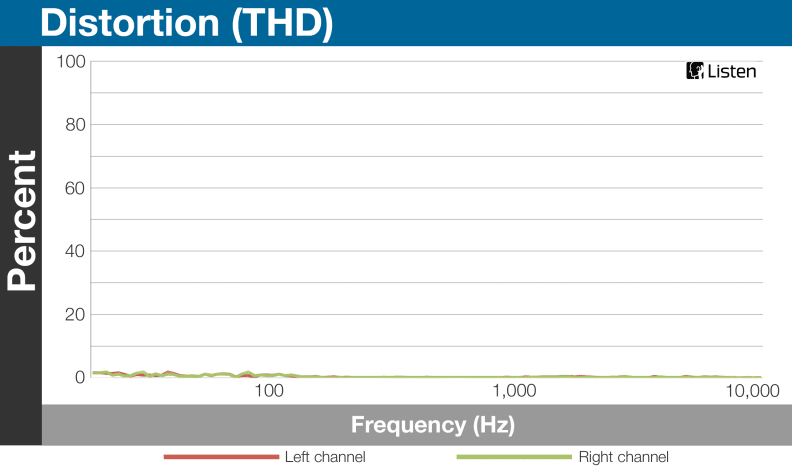
We consider 3% to be the audible level of distortion and the Cerberus only ever reach as high as 2%.
Isolation
Whether it’s the latest tracks on Spotify or the haunting orchestrals of The Witcher 3: Wild Hunt, if noise is leaking in from the outside world the music won’t sound like it was intended to. Headphones can do a lot to mitigate this—like extra padding and a tight fit—but the Cerberus never manages to rise above average. Keep in mind though, these results are based solely on the design of the Cerberus and doesn’t factor in playing music simultaneously.
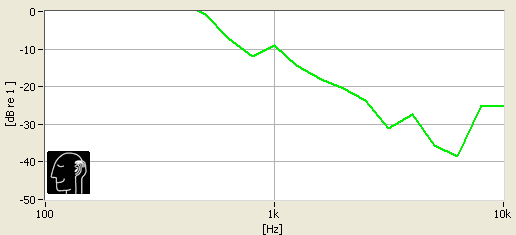
The volume of ambient bass sounds won't be lowered at all, but the volume of upper midrange and treble frequencies will be lowered much more significantly.
As far as sub bass and bass sounds go—like the engines of your local public transportation—the Cerberus won’t be able to block any of that sound from reaching your ears. Ambient sound won’t start to be diminished until the midrange frequencies around 800Hz, at which point it drops to about half of its original volume. Unfortunately, there aren’t a lot of natural sounds in this range so you might not even notice.
The relative volume continues to drop as the frequencies get higher. In the high mids and high frequency ranges (2–20kHz) it quickly drops from half as loud down to an 1/8th of its original volume. Once again, it’s unlikely you’ll encounter sounds in this range, but if you did, they’d be reduced to a shadow of their former levels.
Other Tests
{{ photo_gallery name="Other Tests" }}
Meet the tester
Coming from Buffalo, NY, Nick studied media production and arts journalism. When he’s not writing about tech Nick can be found playing video games and keeping up on the latest in pop culture.
Checking our work.
Our team is here to help you buy the best stuff and love what you own. Our writers, editors, and experts obsess over the products we cover to make sure you're confident and satisfied. Have a different opinion about something we recommend? Email us and we'll compare notes.
Shoot us an email